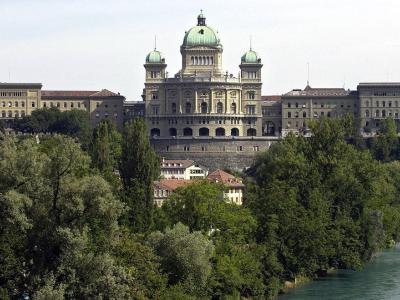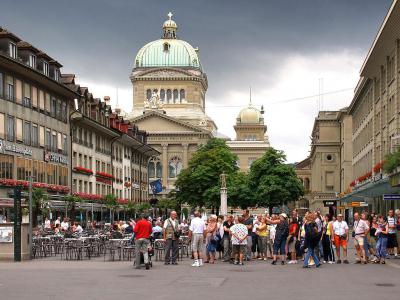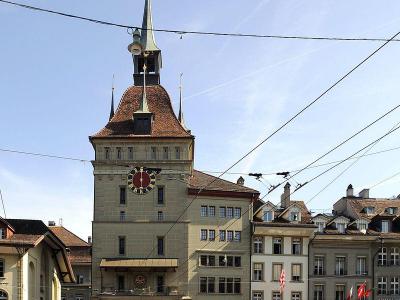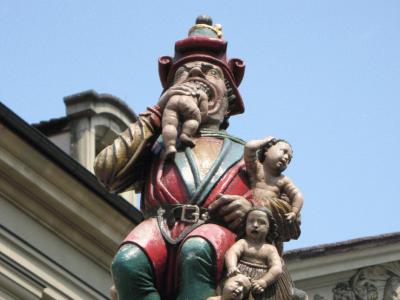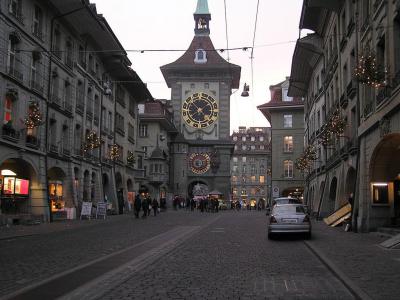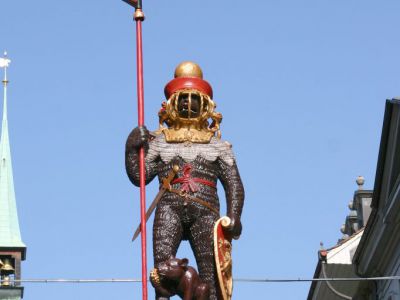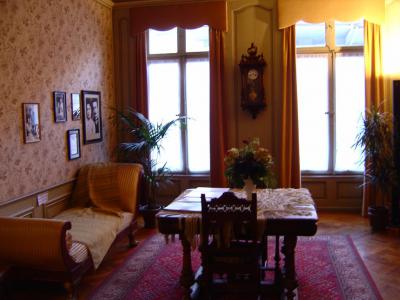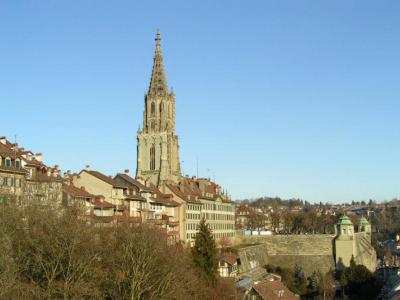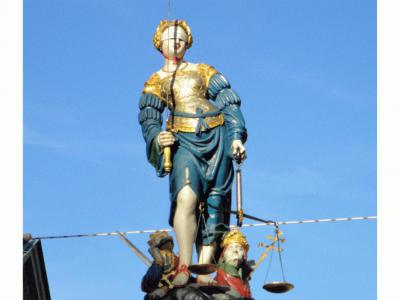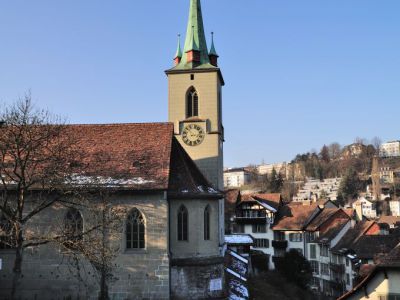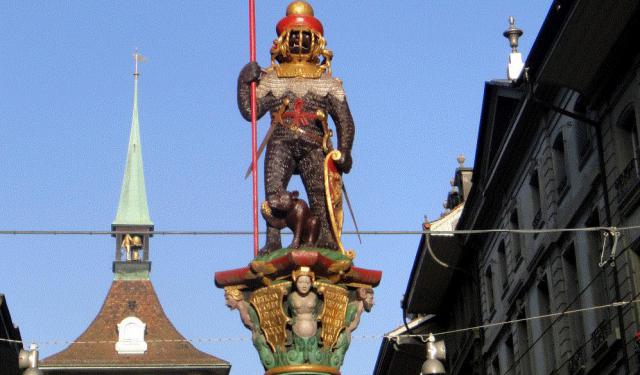Bern Introduction Walking Tour (Self Guided), Bern
The de facto capital of Switzerland, Bern is commonly referred to by the Swiss as the "federal city". Built around a crook in the Aare River, it traces its origins back to the 12th century. According to the local legend, Berchtold V, Duke of Zähringen, founder of Bern, vowed to name the city after the first animal he would kill on the hunt. That animal happened to be a bear, hence the city's name – Bern (meaning “bear” in German). Consequently, the bear has been the heraldic animal of the seal and the coat of arms of the city since the 1220s.
In 1353, Bern joined the Swiss Confederacy, becoming one of the eight cantons of the country's formative period, which lasted from 1353 to 1481. In 1848, Bern was made the seat of the Federal Assembly within the new Swiss federal state.
The historic Old Town of Bern is a UNESCO World Heritage Site. Replete with historical architecture, it contains a plethora of fascinating attractions.
One of the first landmarks that catches your eye while in Bern is the imposing Federal Palace (Bundeshaus). This majestic Neo-Renaissance building is the seat of the Swiss Federal Assembly and the Federal Council, making it the heart of Switzerland's political landscape. Not far away, the Bundesplatz, or Federal Square, serves as a popular gathering place.
As you wander through Bern's charming cobblestone streets, you'll come across the Prison Tower (Käfigturm), a historic structure that once served as a jail.
Further ahead is a somewhat eerie attraction, the Child Eater Fountain (Kindlifresserbrunnen), dating back to the 16th century.
The iconic Clock Tower (Zytglogge), a symbol of Bern's medieval heritage, features a mesmerizing astronomical clock.
For those with a penchant for science, the Einsteinhaus, or Einstein House, is where the renowned physicist Albert Einstein lived while working at the Swiss Patent Office.
No visit to Bern is complete without a stop at the Bern Cathedral (Berner Münster), a stunning example of late Gothic architecture.
The Fountain of Justice (Gerechtigkeitsbrunnen) is another historic gem, depicting the allegorical figure of Lady Justice.
To bask in the beauty of nature, head to the Rose Garden (Rosengarten), a lovely park with a stunning collection of roses and panoramic views of Bern.
Indeed, Bern has no shortage of captivating landmarks and picturesque locations, beckoning visitors to explore them more closely. So, get your camera ready and embark on this self-guided journey to discover the allure of this Swiss gem. You won't be disappointed!
In 1353, Bern joined the Swiss Confederacy, becoming one of the eight cantons of the country's formative period, which lasted from 1353 to 1481. In 1848, Bern was made the seat of the Federal Assembly within the new Swiss federal state.
The historic Old Town of Bern is a UNESCO World Heritage Site. Replete with historical architecture, it contains a plethora of fascinating attractions.
One of the first landmarks that catches your eye while in Bern is the imposing Federal Palace (Bundeshaus). This majestic Neo-Renaissance building is the seat of the Swiss Federal Assembly and the Federal Council, making it the heart of Switzerland's political landscape. Not far away, the Bundesplatz, or Federal Square, serves as a popular gathering place.
As you wander through Bern's charming cobblestone streets, you'll come across the Prison Tower (Käfigturm), a historic structure that once served as a jail.
Further ahead is a somewhat eerie attraction, the Child Eater Fountain (Kindlifresserbrunnen), dating back to the 16th century.
The iconic Clock Tower (Zytglogge), a symbol of Bern's medieval heritage, features a mesmerizing astronomical clock.
For those with a penchant for science, the Einsteinhaus, or Einstein House, is where the renowned physicist Albert Einstein lived while working at the Swiss Patent Office.
No visit to Bern is complete without a stop at the Bern Cathedral (Berner Münster), a stunning example of late Gothic architecture.
The Fountain of Justice (Gerechtigkeitsbrunnen) is another historic gem, depicting the allegorical figure of Lady Justice.
To bask in the beauty of nature, head to the Rose Garden (Rosengarten), a lovely park with a stunning collection of roses and panoramic views of Bern.
Indeed, Bern has no shortage of captivating landmarks and picturesque locations, beckoning visitors to explore them more closely. So, get your camera ready and embark on this self-guided journey to discover the allure of this Swiss gem. You won't be disappointed!
How it works: Download the app "GPSmyCity: Walks in 1K+ Cities" from Apple App Store or Google Play Store to your mobile phone or tablet. The app turns your mobile device into a personal tour guide and its built-in GPS navigation functions guide you from one tour stop to next. The app works offline, so no data plan is needed when traveling abroad.
Bern Introduction Walking Tour Map
Guide Name: Bern Introduction Walking Tour
Guide Location: Switzerland » Bern (See other walking tours in Bern)
Guide Type: Self-guided Walking Tour (Sightseeing)
# of Attractions: 13
Tour Duration: 2 Hour(s)
Travel Distance: 2.6 Km or 1.6 Miles
Author: ChristineS
Sight(s) Featured in This Guide:
Guide Location: Switzerland » Bern (See other walking tours in Bern)
Guide Type: Self-guided Walking Tour (Sightseeing)
# of Attractions: 13
Tour Duration: 2 Hour(s)
Travel Distance: 2.6 Km or 1.6 Miles
Author: ChristineS
Sight(s) Featured in This Guide:
- Bundeshaus (Federal Palace)
- Bundesplatz (Federal Square)
- Käfigturm (Prison Tower)
- Marktgasse (Market Street)
- Kindlifresserbrunnen (Child Eater Fountain)
- Zytglogge (Clock Tower)
- Zahringerbrunnen (Zahringen Fountain)
- Einsteinhaus (Einstein House)
- Berner Münster (The Cathedral of Bern)
- Gerechtigkeitsbrunnen (Fountain of Justice)
- Nydeggkirche (Nydegg Church)
- Untertorbrucke (Lower Gate Bridge)
- Rosengarten (Rose Garden)
1) Bundeshaus (Federal Palace) (must see)
The Federal Palace in Bern serves as the seat of the Swiss Government and Parliament, hosting the Federal Assembly (legislature) and the Federal Council (executive). This architectural landmark, spanning over 300 meters, is a symmetrical complex that embodies Swiss governance and heritage. It consists of three interconnected buildings situated in the southwest of Bern's old city.
The oldest section, the west wing or "Bundeshaus West," was constructed from 1852 to 1857 by Jakob Friedrich Studer to unify the federal administration, government, and parliament. The east wing, "Bundeshaus Ost," was added between 1884 and 1892 by Hans Wilhelm Auer to address growing space needs. Auer then oversaw the construction of the central parliament building from 1894 to 1902, culminating in the current unified complex.
Each wing has a distinct function: the west wing houses two Federal Administration departments, the Federal Chancellery, and the Parliamentary Library, and hosts Federal Council meetings, while two other departments are headquartered in the east wing. These wings, designed with a restrained style to reflect their administrative role, contrast with the monumental central building, which showcases neo-Renaissance architecture, a grand portico, and a striking dome. Its ornate symbolism reflects Swiss history, constitutional principles, and cultural diversity, further emphasized by the use of stone from all regions of the country.
Renovated in the early 21st century, the Federal Palace remains a vital historical monument, listed in the Swiss Inventory of Cultural Assets of National Importance, highlighting its significance in Switzerland's heritage.
Why You Should Visit:
During the week, you can book a guided tour inside the building to learn more about the Swiss Federation's history and how it all started. The view over Bern from the terrace is alone worth the visit!
Tip:
The front side of the building is where you'll find a flea market and cafés, while the back side has a magnificent view perfect for sunset.
Tours run twice a day, with reservations required at least one day before. Languages are German, French, Italian, Rhaeto-Roman, English.
The oldest section, the west wing or "Bundeshaus West," was constructed from 1852 to 1857 by Jakob Friedrich Studer to unify the federal administration, government, and parliament. The east wing, "Bundeshaus Ost," was added between 1884 and 1892 by Hans Wilhelm Auer to address growing space needs. Auer then oversaw the construction of the central parliament building from 1894 to 1902, culminating in the current unified complex.
Each wing has a distinct function: the west wing houses two Federal Administration departments, the Federal Chancellery, and the Parliamentary Library, and hosts Federal Council meetings, while two other departments are headquartered in the east wing. These wings, designed with a restrained style to reflect their administrative role, contrast with the monumental central building, which showcases neo-Renaissance architecture, a grand portico, and a striking dome. Its ornate symbolism reflects Swiss history, constitutional principles, and cultural diversity, further emphasized by the use of stone from all regions of the country.
Renovated in the early 21st century, the Federal Palace remains a vital historical monument, listed in the Swiss Inventory of Cultural Assets of National Importance, highlighting its significance in Switzerland's heritage.
Why You Should Visit:
During the week, you can book a guided tour inside the building to learn more about the Swiss Federation's history and how it all started. The view over Bern from the terrace is alone worth the visit!
Tip:
The front side of the building is where you'll find a flea market and cafés, while the back side has a magnificent view perfect for sunset.
Tours run twice a day, with reservations required at least one day before. Languages are German, French, Italian, Rhaeto-Roman, English.
2) Bundesplatz (Federal Square) (must see)
Bundesplatz, also known as Federal Square, is an old plaza in the center of Bern. Bundesplatz is part of the medieval city center, which is a UNESCO Cultural World Heritage Site.
As a landmark, Bundesplatz is important to see because it is an excellent starting point for any walking tour of Switzerland's capital city. From Bundesplatz, visitors can easily view Bundeshaus, the Swiss Parliament Building that is otherwise known as the Federal Palace. It is also a short walk to such sites as Kafigturm, Hollanderturm and Kleine Schanze park.
Bundesplatz is meaningful in its own right as well. As the central location of the Old City, visitors can walk on the land that was first settled in the 12th century. Duke Berchtold V of Zahringen chose the area because it was encased on three sides by the Aare, a tributary of the Rhine. The first expansion of the city began in 1191 with several more taking place over the next 300 years.
As traffic grew in Bern, so did the need for parking. Bundesplatz was used as a parking lot from 1945 through 2003. At that time, the site was redesigned with natural stone slabs and 26 fountains that represent the 26 cantons. At dusk, a light band is illuminated that guides a curved path to the parliament building.
Visitors should consider spending an evening at Bundesplatz where they can enjoy the light show at different points throughout the year. Dancing lights are projected onto the Federal Palace three times in the evenings with a fourth performance on weekends.
Why You Should Visit:
More than just a nice place to walk around, there is usually some form of activity going on such as a festival with crafts and food being sold and, weather permitting, you can sit outside and watch the bustle.
Tips:
Those who aren't in the city during the light show can still enjoy the illuminated beauty of the Federal Building and the 26 fountains.
As a landmark, Bundesplatz is important to see because it is an excellent starting point for any walking tour of Switzerland's capital city. From Bundesplatz, visitors can easily view Bundeshaus, the Swiss Parliament Building that is otherwise known as the Federal Palace. It is also a short walk to such sites as Kafigturm, Hollanderturm and Kleine Schanze park.
Bundesplatz is meaningful in its own right as well. As the central location of the Old City, visitors can walk on the land that was first settled in the 12th century. Duke Berchtold V of Zahringen chose the area because it was encased on three sides by the Aare, a tributary of the Rhine. The first expansion of the city began in 1191 with several more taking place over the next 300 years.
As traffic grew in Bern, so did the need for parking. Bundesplatz was used as a parking lot from 1945 through 2003. At that time, the site was redesigned with natural stone slabs and 26 fountains that represent the 26 cantons. At dusk, a light band is illuminated that guides a curved path to the parliament building.
Visitors should consider spending an evening at Bundesplatz where they can enjoy the light show at different points throughout the year. Dancing lights are projected onto the Federal Palace three times in the evenings with a fourth performance on weekends.
Why You Should Visit:
More than just a nice place to walk around, there is usually some form of activity going on such as a festival with crafts and food being sold and, weather permitting, you can sit outside and watch the bustle.
Tips:
Those who aren't in the city during the light show can still enjoy the illuminated beauty of the Federal Building and the 26 fountains.
3) Käfigturm (Prison Tower) (must see)
The Old City of Bern has countless sights to see. Among those landmarks is Kafigturm, the medieval prison tower. This must-see spot is a short walk from Bundesplatz and only minutes from numerous historical sites, statues and fountains.
Käfigturm as it stands today was built in 1640. The original tower, which was built in 1256, was demolished as it had fallen into disrepair. The replacement was built by Joseph Plepp, Antoni Graber and Hans Stähli to hold about 60 to 70 prisoners.
The tower was used as a prison through the late 19th century. Once prisoners were no longer held in the Käfigturm the role of the tower changed. It was, at different times, used to store state archives and court records. It held a wine shop. It was a library and an exhibition center.
Käfigturm isn't the only clock tower in Bern. However, it may be the most striking. The bell dates to 1643 and still functions today. Originally, the bell was struck by hand. A mechanism for striking wasn't added until the 19th century, but it still rings as long as the clock is tightened. An inscription on the bell, which was made in eastern France, reads, "May my voice be a terror to all evil spirts."
Serving a dual purpose as a prison and a city gate, visitors can still walk through the tower or ride a trolley that travels along Marktgasse. Tourists can also enter the building, though tours often focus on the building's exterior rather than its interior.
Why You Should Visit:
To see a tower where prisoners were once held in the Old City.
To admire the historic clockwork, bell and city gate.
Tip:
If you plan your walking tour around Marktgasse you will easily reach Käfigturm. Don't be afraid to linger as the streets are made to be friendly to pedestrians.
Käfigturm as it stands today was built in 1640. The original tower, which was built in 1256, was demolished as it had fallen into disrepair. The replacement was built by Joseph Plepp, Antoni Graber and Hans Stähli to hold about 60 to 70 prisoners.
The tower was used as a prison through the late 19th century. Once prisoners were no longer held in the Käfigturm the role of the tower changed. It was, at different times, used to store state archives and court records. It held a wine shop. It was a library and an exhibition center.
Käfigturm isn't the only clock tower in Bern. However, it may be the most striking. The bell dates to 1643 and still functions today. Originally, the bell was struck by hand. A mechanism for striking wasn't added until the 19th century, but it still rings as long as the clock is tightened. An inscription on the bell, which was made in eastern France, reads, "May my voice be a terror to all evil spirts."
Serving a dual purpose as a prison and a city gate, visitors can still walk through the tower or ride a trolley that travels along Marktgasse. Tourists can also enter the building, though tours often focus on the building's exterior rather than its interior.
Why You Should Visit:
To see a tower where prisoners were once held in the Old City.
To admire the historic clockwork, bell and city gate.
Tip:
If you plan your walking tour around Marktgasse you will easily reach Käfigturm. Don't be afraid to linger as the streets are made to be friendly to pedestrians.
4) Marktgasse (Market Street)
Market Street (Marktgasse) is a historically significant street nestled in the medieval center of Bern. Dating back to the 13th century, it is part of the Innere Neustadt and stretches from the Käfigturm clock tower in the west to the iconic Zytglogge tower in the east. This vibrant street lies within the UNESCO Cultural World Heritage Site that encompasses Bern's Old City.
First recorded in 1286, Market Street was initially known as Innere Neuenstadt after the 3rd city wall was constructed, before being unofficially called Neuenstadt until the early 19th century. Its modern name, Market Street, emerged in 1798 but gained widespread acceptance only in the early 20th century.
The street is a lively hub, lined with historic buildings that house retailers and restaurants. Visitors will encounter charming arcades and impressive fountains that embody Bern's old-world allure. Notable is the Schützenbrunnen, a 16th-century fountain portraying a rifleman carrying a sword and a banner to honor the Gesellschaft zu Schützen. Historically significant fountains, like the Schützenbrunnen and Anna-Seiler-Brunnen, grace the Market Street, illustrating Bern's Renaissance wealth and prosperity. These public water sources, which number over 100 across the city, have served as social gathering spots for centuries.
Dominating the eastern end of the street is the Zytglogge, a medieval tower with an astronomical clock that originally served as a gate in Bern's western fortification walls. It later functioned as a prison and remains one of the city's most recognized landmarks. Market Street’s cobbled stones and medieval architecture make it a fascinating destination, seamlessly blending commerce, history, and culture in the heart of Bern.
First recorded in 1286, Market Street was initially known as Innere Neuenstadt after the 3rd city wall was constructed, before being unofficially called Neuenstadt until the early 19th century. Its modern name, Market Street, emerged in 1798 but gained widespread acceptance only in the early 20th century.
The street is a lively hub, lined with historic buildings that house retailers and restaurants. Visitors will encounter charming arcades and impressive fountains that embody Bern's old-world allure. Notable is the Schützenbrunnen, a 16th-century fountain portraying a rifleman carrying a sword and a banner to honor the Gesellschaft zu Schützen. Historically significant fountains, like the Schützenbrunnen and Anna-Seiler-Brunnen, grace the Market Street, illustrating Bern's Renaissance wealth and prosperity. These public water sources, which number over 100 across the city, have served as social gathering spots for centuries.
Dominating the eastern end of the street is the Zytglogge, a medieval tower with an astronomical clock that originally served as a gate in Bern's western fortification walls. It later functioned as a prison and remains one of the city's most recognized landmarks. Market Street’s cobbled stones and medieval architecture make it a fascinating destination, seamlessly blending commerce, history, and culture in the heart of Bern.
5) Kindlifresserbrunnen (Child Eater Fountain)
The Child Eater Fountain (Kindlifresserbrunnen) stands in the Granary Place in Bern and is one of the city's notable 16th-century fountains. Created between 1545 and 1546 by Hans Gieng, it replaced an earlier wooden fountain from the 15th century. Initially called Plaza Fountain, the current name, Child Eater Fountain, was first used in 1666. In Swiss German, "Kindli" is a diminutive form of "Kind," meaning child, and thus the name translates to "Fountain of the Eater of Little Children."
The fountain's sculpture depicts a seated ogre, devouring a naked child with a sack of other children by his side. The ogre is adorned with a pointed hat resembling a Jewish one, leading to speculation that the figure could represent a Jew as part of an antisemitic blood libel. Other theories suggest it portrays the beast-like Krampus from Alpine folklore, who punishes misbehaving children, or the Greek Titan Cronus, who devoured his offspring.
An additional theory is that the ogre symbolizes an enemy threatening the Old Swiss Confederacy's eight cantons, represented by the eight children. This interpretation aligns with the fountain's base, which displays a frieze of armed bears, possibly designed by Hans Rudolf Manuel Deutsch, marching to war.
Despite these various interpretations, the true origin remains uncertain. The fountain might simply represent a carnival figure intended to frighten unruly children during Fastnacht, Switzerland's "Night of Fasting" festival. Regardless of its original purpose, the Child Eater Fountain has intrigued and terrified generations for almost 500 years. The fountain also features prominently in Jacques Chessex's novel L'Ogre (The Ogre).
The fountain's sculpture depicts a seated ogre, devouring a naked child with a sack of other children by his side. The ogre is adorned with a pointed hat resembling a Jewish one, leading to speculation that the figure could represent a Jew as part of an antisemitic blood libel. Other theories suggest it portrays the beast-like Krampus from Alpine folklore, who punishes misbehaving children, or the Greek Titan Cronus, who devoured his offspring.
An additional theory is that the ogre symbolizes an enemy threatening the Old Swiss Confederacy's eight cantons, represented by the eight children. This interpretation aligns with the fountain's base, which displays a frieze of armed bears, possibly designed by Hans Rudolf Manuel Deutsch, marching to war.
Despite these various interpretations, the true origin remains uncertain. The fountain might simply represent a carnival figure intended to frighten unruly children during Fastnacht, Switzerland's "Night of Fasting" festival. Regardless of its original purpose, the Child Eater Fountain has intrigued and terrified generations for almost 500 years. The fountain also features prominently in Jacques Chessex's novel L'Ogre (The Ogre).
6) Zytglogge (Clock Tower) (must see)
The Clock Tower (Zytglogge), a medieval tower in Bern, stands as a multifaceted monument deeply embedded in the city's history and culture. Constructed around 1218–1220, initially as a guard tower for the city's western fortifications, the Clock Tower has evolved through various roles including a prison and a clock tower. This evolution reflects Bern’s historical journey following its de facto independence from the Empire.
Standing 54.5 meters tall with a footprint of 11.2 by 10.75 meters, the Clock Tower's structure is a testament to medieval architecture. The exterior, largely shaped during the 1770 renovation, features alpine limestone and sandstone cladding, decorative corner blocks, and a late Gothic cornice. A distinguishing feature is the tower's red-tiled Gothic spire, which hosts spire lights and ornamental urns, topped with a gilded knob and a weather vane bearing the Bernese coat of arms.
Internally, the Clock Tower has undergone numerous changes, especially as its function shifted across centuries. Initially a basic guard tower, it was later filled with additional floors in the fourteenth century. These rooms have variously served as city archives, storerooms, and even an air raid shelter, reflecting the tower’s central role in civic administration. Since 1979, these rooms have been cleared and now are showcased only during guided tours.
The Clock Tower is also renowned for its 15th-century astronomical clock, a major draw for tourists. As the clock nears the hour, visitors gather to watch a captivating mechanical performance featuring figures like bears, a jester, Chronos (the god of time), and a golden rooster, all of which animate in a delightful display.
For those willing to climb the 130 steps inside the tower, there awaits a stunning panoramic view of the UNESCO World Heritage Site that includes Bern's historic old city, with its characteristic tiled roofs and narrow lanes, extending out to the peaks of the Bernese Oberland on clear days.
Why You Should Visit:
To experience a wonderful example of the Swiss tradition of timekeeping – how often do you see an 800-year-old clock?
Tip:
The animation is best seen during the higher numbered hours (e.g. 12 at noon), but keep in mind that mass transit (buses & streetcars) does not stop during that time so beware of traffic at the intersection.
There's also a daily tour (except in winter months) at 2:30 pm provided in English, German, and French – pre-book it online! They take you up inside the tower to the different levels and explain the history and inner workings – very interesting!
Standing 54.5 meters tall with a footprint of 11.2 by 10.75 meters, the Clock Tower's structure is a testament to medieval architecture. The exterior, largely shaped during the 1770 renovation, features alpine limestone and sandstone cladding, decorative corner blocks, and a late Gothic cornice. A distinguishing feature is the tower's red-tiled Gothic spire, which hosts spire lights and ornamental urns, topped with a gilded knob and a weather vane bearing the Bernese coat of arms.
Internally, the Clock Tower has undergone numerous changes, especially as its function shifted across centuries. Initially a basic guard tower, it was later filled with additional floors in the fourteenth century. These rooms have variously served as city archives, storerooms, and even an air raid shelter, reflecting the tower’s central role in civic administration. Since 1979, these rooms have been cleared and now are showcased only during guided tours.
The Clock Tower is also renowned for its 15th-century astronomical clock, a major draw for tourists. As the clock nears the hour, visitors gather to watch a captivating mechanical performance featuring figures like bears, a jester, Chronos (the god of time), and a golden rooster, all of which animate in a delightful display.
For those willing to climb the 130 steps inside the tower, there awaits a stunning panoramic view of the UNESCO World Heritage Site that includes Bern's historic old city, with its characteristic tiled roofs and narrow lanes, extending out to the peaks of the Bernese Oberland on clear days.
Why You Should Visit:
To experience a wonderful example of the Swiss tradition of timekeeping – how often do you see an 800-year-old clock?
Tip:
The animation is best seen during the higher numbered hours (e.g. 12 at noon), but keep in mind that mass transit (buses & streetcars) does not stop during that time so beware of traffic at the intersection.
There's also a daily tour (except in winter months) at 2:30 pm provided in English, German, and French – pre-book it online! They take you up inside the tower to the different levels and explain the history and inner workings – very interesting!
7) Zahringerbrunnen (Zahringen Fountain)
The Zähringen Fountain (Zähringerbrunnen) is an iconic cultural monument located on Kramgasse in the Old City of Bern, a UNESCO World Heritage Site. This fountain stands as a testament to Bern's medieval heritage and its founders, the Zähringen family. Erected in 1535, the Zähringen Fountain was constructed to commemorate Berchtold von Zähringer, the founder of Bern, who, according to local legend, chose the location for the city after hunting down a bear on the Aare peninsula.
Dominating the fountain is a statue of a bear, the heraldic symbol of Bern, clad in full armor. This bear holds a shield and a banner, both adorned with the golden lion on a red background, the emblem of the Zähringen family. At the bear's feet is a smaller bear cub, which adds a touch of charm to the ensemble by seemingly munching on grapes.
The original basin of the fountain, dated 1542, was octagonal and bore various inscriptions including "Protege Nos Domine" (Protect us, Lord) and "Soli Deo Gloria" (Glory to God alone). This basin was replaced in 1889 with a design replicating that of the Pfeiferbrunnen's basin, alongside refurbishments to the statue and column.
The Zähringen Fountain not only serves as a reminder of Bern's foundation and its symbolic bears but also as an artistic and cultural property of national significance, enriching the historical ambiance of the city's well-preserved medieval streetscape.
Dominating the fountain is a statue of a bear, the heraldic symbol of Bern, clad in full armor. This bear holds a shield and a banner, both adorned with the golden lion on a red background, the emblem of the Zähringen family. At the bear's feet is a smaller bear cub, which adds a touch of charm to the ensemble by seemingly munching on grapes.
The original basin of the fountain, dated 1542, was octagonal and bore various inscriptions including "Protege Nos Domine" (Protect us, Lord) and "Soli Deo Gloria" (Glory to God alone). This basin was replaced in 1889 with a design replicating that of the Pfeiferbrunnen's basin, alongside refurbishments to the statue and column.
The Zähringen Fountain not only serves as a reminder of Bern's foundation and its symbolic bears but also as an artistic and cultural property of national significance, enriching the historical ambiance of the city's well-preserved medieval streetscape.
8) Einsteinhaus (Einstein House) (must see)
The Einstein House (Einsteinhaus) in Bern is not only a historical site but also a museum dedicated to the life and work of Albert Einstein, one of the most revolutionary physicists of the 20th century. Located on Kramgasse in the picturesque city of Bern, this former residence of Einstein holds significant historical importance. From 1903 to 1905, during his time working at the Federal Institute of Intellectual Property, Einstein lived here with his wife Mileva Marić, and their son Hans.
The museum showcases the apartment where Einstein and his family lived, meticulously preserved to reflect the living conditions and style of the early 1900s. This personal space is where Einstein formulated some of his most profound scientific contributions, including the Annus Mirabilis papers. These papers, which were published in the Annals of Physics, laid the groundwork for modern physics and introduced his theory of relativity.
Visitors to the Einstein House can explore the second floor, which offers a glimpse into Einstein's domestic life through original furnishings and memorabilia. The third floor serves as an educational journey through Einstein's biography and the expansive reach of his scientific achievements. Additionally, a smaller, permanent exhibition related to Einstein is hosted at the Historical Museum of Bern.
This residence-turned-museum not only celebrates Einstein's scientific achievements but also commemorates his time in Bern from 1902 to 1909, highlighting his significant connection to Switzerland. As a tribute to one of Switzerland's most illustrious immigrants, the Einstein House stands as a testament to the legacy of a man whose theories reshaped our understanding of the universe.
Why You Should Visit:
If you don't expect huge, interactive exhibitions, this tiny museum is a very enjoyable, informative visit – also inexpensive and not crowded.
There is also a small coffee shop by the same name on street level which is quite convenient for a break in the city walk.
Tip:
Be sure to watch the 20-minute video upstairs as it supplements the rear of the exhibits. Then there's a lot of reading – but it's quite fascinating.
This place is not at all accessible for anybody with any difficulty walking – the stairs are spiraled but difficult to walk up and down.
The museum showcases the apartment where Einstein and his family lived, meticulously preserved to reflect the living conditions and style of the early 1900s. This personal space is where Einstein formulated some of his most profound scientific contributions, including the Annus Mirabilis papers. These papers, which were published in the Annals of Physics, laid the groundwork for modern physics and introduced his theory of relativity.
Visitors to the Einstein House can explore the second floor, which offers a glimpse into Einstein's domestic life through original furnishings and memorabilia. The third floor serves as an educational journey through Einstein's biography and the expansive reach of his scientific achievements. Additionally, a smaller, permanent exhibition related to Einstein is hosted at the Historical Museum of Bern.
This residence-turned-museum not only celebrates Einstein's scientific achievements but also commemorates his time in Bern from 1902 to 1909, highlighting his significant connection to Switzerland. As a tribute to one of Switzerland's most illustrious immigrants, the Einstein House stands as a testament to the legacy of a man whose theories reshaped our understanding of the universe.
Why You Should Visit:
If you don't expect huge, interactive exhibitions, this tiny museum is a very enjoyable, informative visit – also inexpensive and not crowded.
There is also a small coffee shop by the same name on street level which is quite convenient for a break in the city walk.
Tip:
Be sure to watch the 20-minute video upstairs as it supplements the rear of the exhibits. Then there's a lot of reading – but it's quite fascinating.
This place is not at all accessible for anybody with any difficulty walking – the stairs are spiraled but difficult to walk up and down.
9) Berner Münster (The Cathedral of Bern) (must see)
The Cathedral of Bern (Berner Münster) stands prominently in the Old City of Bern as a symbol of the city-state's burgeoning power. This Swiss Reformed cathedral, constructed in the Gothic style, began its development in 1421. However, its iconic tower, reaching 100.6 meters (330 feet), was not completed until 1893, making it the tallest cathedral in Switzerland. Due to its architectural and cultural significance, it has been designated as a Cultural Property of National Significance.
Designed to impress both citizens and foreign visitors, the cathedral's interior boasts a central nave that exemplifies the Gothic style, featuring an elegant and intricate design with grand stained glass windows and various altars in its side chapels. The Gothic architecture also enabled a higher central nave and expansive windows, contributing to an airy and well-lit ambiance.
The cathedral's most striking feature is its main portal, which portrays the Last Judgement in an impressive display of 47 large statues and 170 smaller figures. This depiction, which survived the Protestant Reformation's iconoclasm, is regarded as one of the finest in Europe, illustrating the division of the righteous and the wicked with remarkable artistry.
Tip:
If you are so inclined on a beautiful day, climb the steeple. There is an access charge but if the weather is nice, you get a very nice view of Bern and the Alps. Be cautious of your time as you can be right next to the ten-ton bell (the largest in the whole of Switzerland) when it rings at 6 pm. While it is possible to stand near the bells when they are rung, it is necessary to cover your ears to prevent hearing damage.
Designed to impress both citizens and foreign visitors, the cathedral's interior boasts a central nave that exemplifies the Gothic style, featuring an elegant and intricate design with grand stained glass windows and various altars in its side chapels. The Gothic architecture also enabled a higher central nave and expansive windows, contributing to an airy and well-lit ambiance.
The cathedral's most striking feature is its main portal, which portrays the Last Judgement in an impressive display of 47 large statues and 170 smaller figures. This depiction, which survived the Protestant Reformation's iconoclasm, is regarded as one of the finest in Europe, illustrating the division of the righteous and the wicked with remarkable artistry.
Tip:
If you are so inclined on a beautiful day, climb the steeple. There is an access charge but if the weather is nice, you get a very nice view of Bern and the Alps. Be cautious of your time as you can be right next to the ten-ton bell (the largest in the whole of Switzerland) when it rings at 6 pm. While it is possible to stand near the bells when they are rung, it is necessary to cover your ears to prevent hearing damage.
10) Gerechtigkeitsbrunnen (Fountain of Justice) (must see)
In a city with over a hundred fountains, the Fountain of Justice (Gerechtigkeitsbrunnen) in Bern's Old City is a standout attraction. It is the only fountain in Bern that has maintained all its original design features and is recognized as a national cultural heritage site.
Hans Gieng's renowned statue of Lady Justice elevates the Fountain of Justice above other Bernese fountains in artistic value. This iconic figure was replicated across Switzerland until the mid-17th century. At Justice's feet, four smaller busts encircle the base: a Pope, an Emperor, a Sultan, and a Schultheiss. The Schultheiss’s gold chain of office is believed to have originally displayed Bern's emblem. Each figure's eyes are shut, symbolizing submission. They represent the Four Earthly Powers as outlined by Renaissance humanism: theocracy (Pope), monarchy (Emperor), autocracy (Sultan), and republic (Schultheiss).
The statue illustrates how Justice reigns supreme over all earthly rulers-a variation of the medieval motif of virtue conquering vice. Divine Justice was a popular topic in Reformation-era Bern. Reformers believed that practicing justice according to God's word was the highest responsibility of any authority, outweighing feudal rights. They used this argument, among others, to rationalize Bern's takeover of Vaud in 1536 from the Savoy dukes.
While the sword and scales are typical symbols of Lady Justice, the Bern statue's blindfold is a unique addition. This feature later became a widely recognized representation of Justice and a universal sign of equality before the law. The blindfold implies that justice should be served impartially, with decisions made through thoughtful reflection rather than external appearances. Gieng's Lady Justice embodies the principle of republican justice and served as a compelling public reminder of the Bernese Republic's legal authority.
Hans Gieng's renowned statue of Lady Justice elevates the Fountain of Justice above other Bernese fountains in artistic value. This iconic figure was replicated across Switzerland until the mid-17th century. At Justice's feet, four smaller busts encircle the base: a Pope, an Emperor, a Sultan, and a Schultheiss. The Schultheiss’s gold chain of office is believed to have originally displayed Bern's emblem. Each figure's eyes are shut, symbolizing submission. They represent the Four Earthly Powers as outlined by Renaissance humanism: theocracy (Pope), monarchy (Emperor), autocracy (Sultan), and republic (Schultheiss).
The statue illustrates how Justice reigns supreme over all earthly rulers-a variation of the medieval motif of virtue conquering vice. Divine Justice was a popular topic in Reformation-era Bern. Reformers believed that practicing justice according to God's word was the highest responsibility of any authority, outweighing feudal rights. They used this argument, among others, to rationalize Bern's takeover of Vaud in 1536 from the Savoy dukes.
While the sword and scales are typical symbols of Lady Justice, the Bern statue's blindfold is a unique addition. This feature later became a widely recognized representation of Justice and a universal sign of equality before the law. The blindfold implies that justice should be served impartially, with decisions made through thoughtful reflection rather than external appearances. Gieng's Lady Justice embodies the principle of republican justice and served as a compelling public reminder of the Bernese Republic's legal authority.
11) Nydeggkirche (Nydegg Church)
At the eastern edge of the Old City of Bern lies Nydeggkirche, or the Nydegg Church. This church was built in 1341 and completed in 1346. The original tower replaced an old fortress in the city, but it was refurbished over the years once it was sanctified to the Mary Magdalene Brotherhood. A tower and new nave were added in the late 15th and early 16th centuries to complete its renovation.
Nydeggkirche suffered its share of losses. The Protestant reformation caused the church to be used as a warehouse for a brief time. A fire caused significant damage to the bell tower, roof and clockwork. Luckily, repairs were possible and the church has been in service for more than 400 years.
Today, the Nydeggkirche is a part of the Reformed Churches of the Canton Bern-Jura-Solothurn. Visitors are welcome to take part in services or to admire the Gothic architecture. They may also wish to view the church to pay homage to one of the first European churches to perform a same-sex union.
Tip:
From the banks of the river, you can take a photo of the Nydegg Church and the Nydegg Bridge.
Nydeggkirche suffered its share of losses. The Protestant reformation caused the church to be used as a warehouse for a brief time. A fire caused significant damage to the bell tower, roof and clockwork. Luckily, repairs were possible and the church has been in service for more than 400 years.
Today, the Nydeggkirche is a part of the Reformed Churches of the Canton Bern-Jura-Solothurn. Visitors are welcome to take part in services or to admire the Gothic architecture. They may also wish to view the church to pay homage to one of the first European churches to perform a same-sex union.
Tip:
From the banks of the river, you can take a photo of the Nydegg Church and the Nydegg Bridge.
12) Untertorbrucke (Lower Gate Bridge)
The Lower Gate Bridge (Untertorbrücke) is an integral piece of Bern, Switzerland's architectural and historical heritage. This historic stone arch bridge, which spans the Aare River, was initially constructed in 1256, making it the oldest of Bern's Aare bridges. For centuries, it served as the sole bridge connecting the Old City to the eastern bank of the river, reflecting its vital role in the city’s early development.
The bridge's origins trace back to the urgent need for a river crossing after Bern's founding in 1191. Conflict soon arose with Count Hartmann of Kyburg, leading to a mediated peace allowing for the bridge’s completion. Initially built from oak wood and possibly partially covered, it featured fortifications including a fortified tower and a central guard house. The bridge endured significant historical events, including surviving an attack during King Rudolph of Habsburg's second siege of Bern in 1288.
In 1460, after being severely damaged by a flood, a decision was made to reconstruct the bridge in stone. The work was entrusted to a master from Zurich, leading to significant improvements including new fortifications and a chapel consecrated by 1467. However, construction faced delays due to financial strains and conflicts, finally completing in the late 15th century.
Throughout the following centuries, the bridge’s fortifications were enhanced, including the addition of crenelated stone walls and covered battlements. By the 18th century, however, these medieval fortifications lost their military relevance and became traffic hindrances, leading to major renovations in 1757. The original military features were removed, and new decorative elements, including a baroque triumphal arch, were added.
Subsequent modifications in the 19th century further altered its appearance; iron railings replaced sandstone parapets, and significant structures such as the eastern gate and drawbridge were dismantled to ease local congestion.
Today, the Lower Gate Bridge stands primarily as a vestige of its medieval core, stripped of its extensive fortifications and baroque embellishments. It now serves as a quiet testament to Bern’s long history, encapsulating centuries of architectural and urban evolution. No longer an active bridge, it remains a symbolic link to the city’s past, continuing to offer a glimpse into the historical narrative of Bern.
The bridge's origins trace back to the urgent need for a river crossing after Bern's founding in 1191. Conflict soon arose with Count Hartmann of Kyburg, leading to a mediated peace allowing for the bridge’s completion. Initially built from oak wood and possibly partially covered, it featured fortifications including a fortified tower and a central guard house. The bridge endured significant historical events, including surviving an attack during King Rudolph of Habsburg's second siege of Bern in 1288.
In 1460, after being severely damaged by a flood, a decision was made to reconstruct the bridge in stone. The work was entrusted to a master from Zurich, leading to significant improvements including new fortifications and a chapel consecrated by 1467. However, construction faced delays due to financial strains and conflicts, finally completing in the late 15th century.
Throughout the following centuries, the bridge’s fortifications were enhanced, including the addition of crenelated stone walls and covered battlements. By the 18th century, however, these medieval fortifications lost their military relevance and became traffic hindrances, leading to major renovations in 1757. The original military features were removed, and new decorative elements, including a baroque triumphal arch, were added.
Subsequent modifications in the 19th century further altered its appearance; iron railings replaced sandstone parapets, and significant structures such as the eastern gate and drawbridge were dismantled to ease local congestion.
Today, the Lower Gate Bridge stands primarily as a vestige of its medieval core, stripped of its extensive fortifications and baroque embellishments. It now serves as a quiet testament to Bern’s long history, encapsulating centuries of architectural and urban evolution. No longer an active bridge, it remains a symbolic link to the city’s past, continuing to offer a glimpse into the historical narrative of Bern.
13) Rosengarten (Rose Garden) (must see)
Any lover of the great outdoors should not miss Rosengarten, Bern's beautiful Rose Garden. It is worth a trip to the Swiss city just to see the more than 400 varities of roses and irises that populate the park.
In additional to roses, there are over 20 varieties of rhododendrons. There is also a water lily pond, Japanese cherry trees and 12 linden trees.
In addition to the flora, the park has space for lounging, walking or simply enjoying the city. Visitors can sit on park benches, read at the pavilion and attached library, explore the playground or even build a sandcastle. Rosengarten offers excellent views of Bern, which makes it the perfect spot for photographers.
Tourists can also stop to eat at the Rosengarten restaurant or have a picnic lunch within the garden itself while spying the banks of the Aare or admiring one of the park's statues. A recent tribute to Albert Einstein is one such statue that is often appreciated by visitors.
This park was turned into a recreational public space in 1913. Prior to that, it served as a cemetery from 1765 to 1877.
Why You Should Visit:
To get some of the best views of Bern
To give children a safe and open place to run and play
Tips:
Visitors can Rosengarten any time of the year. While the roses bloom in the summer months, changing fall leaves and spring cherry blossoms are beautiful sights. Even the winter offers views that cannot be replicated anywhere else in Bern.
In additional to roses, there are over 20 varieties of rhododendrons. There is also a water lily pond, Japanese cherry trees and 12 linden trees.
In addition to the flora, the park has space for lounging, walking or simply enjoying the city. Visitors can sit on park benches, read at the pavilion and attached library, explore the playground or even build a sandcastle. Rosengarten offers excellent views of Bern, which makes it the perfect spot for photographers.
Tourists can also stop to eat at the Rosengarten restaurant or have a picnic lunch within the garden itself while spying the banks of the Aare or admiring one of the park's statues. A recent tribute to Albert Einstein is one such statue that is often appreciated by visitors.
This park was turned into a recreational public space in 1913. Prior to that, it served as a cemetery from 1765 to 1877.
Why You Should Visit:
To get some of the best views of Bern
To give children a safe and open place to run and play
Tips:
Visitors can Rosengarten any time of the year. While the roses bloom in the summer months, changing fall leaves and spring cherry blossoms are beautiful sights. Even the winter offers views that cannot be replicated anywhere else in Bern.
Walking Tours in Bern, Switzerland
Create Your Own Walk in Bern
Creating your own self-guided walk in Bern is easy and fun. Choose the city attractions that you want to see and a walk route map will be created just for you. You can even set your hotel as the start point of the walk.
Bern's Historical Churches
They say architecture should speak of its time and place, but yearn for timelessness. While the outside appearances of historical churches in Bern beckon seekers of beauty and tranquility, the ethereal atmosphere within embraces the visitor with a sense of timeless serenity.
Enveloped within Bern's historic old town, the Church of the Holy Ghost (Heiliggeistkirche) is one of the largest... view more
Tour Duration: 1 Hour(s)
Travel Distance: 1.9 Km or 1.2 Miles
Enveloped within Bern's historic old town, the Church of the Holy Ghost (Heiliggeistkirche) is one of the largest... view more
Tour Duration: 1 Hour(s)
Travel Distance: 1.9 Km or 1.2 Miles
Fountains and Statues Walking Tour
With over 100 public fountains in the Old Town alone, Bern has a well-deserved reputation as the "City of Fountains". During medieval times, local life revolved around fountains as they provided water for residents and served as locations for news exchange and social gatherings.
Throughout history, Bernese residents have cherished their fountains and decorated them with elaborate... view more
Tour Duration: 1 Hour(s)
Travel Distance: 1.6 Km or 1 Miles
Throughout history, Bernese residents have cherished their fountains and decorated them with elaborate... view more
Tour Duration: 1 Hour(s)
Travel Distance: 1.6 Km or 1 Miles
Useful Travel Guides for Planning Your Trip
Swiss Sweets and Pastries
Among other things that make Switzerland popular around the world, chocolate is definitely the one. Still, chocolate isn't the only Swiss-made sweet deserving attention, as there are plenty of baked products, such as Magenbrot, Vermicelles, and Biberli, to mention but a few, that are well worth...
The Most Popular Cities
/ view all



